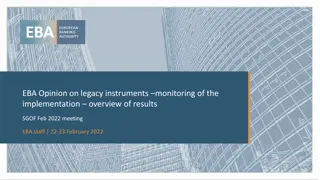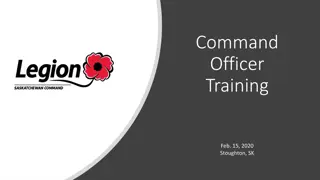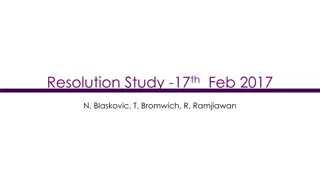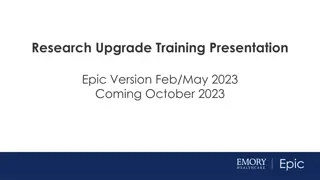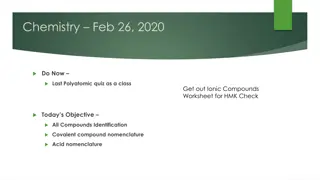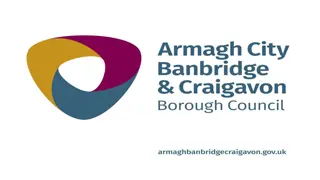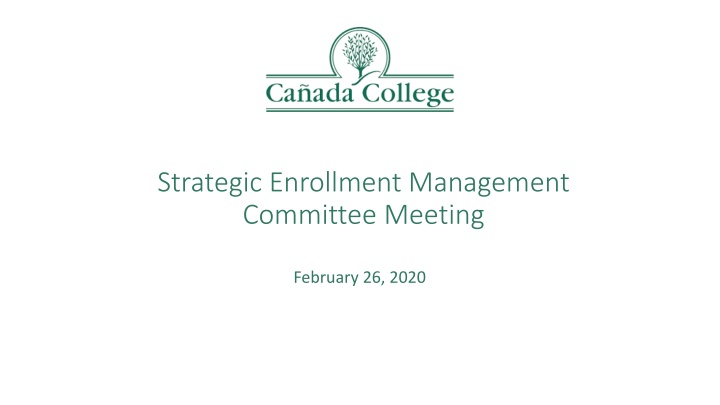
Strategic Enrollment Management Committee Meeting Summary
The Strategic Enrollment Management Committee Meeting on February 26, 2020, discussed finalizing SEM strategies, reviewing and approving SEM objectives, guiding principles, responsible parties, timelines, and metrics. The plan outlined objectives such as re-envisioning distance education, maximizing student completion rates, and aligning support services for student success. Responsibilities, timelines, and metrics were assigned to ensure the effective implementation of the SEM plan.
Download Presentation

Please find below an Image/Link to download the presentation.
The content on the website is provided AS IS for your information and personal use only. It may not be sold, licensed, or shared on other websites without obtaining consent from the author. If you encounter any issues during the download, it is possible that the publisher has removed the file from their server.
You are allowed to download the files provided on this website for personal or commercial use, subject to the condition that they are used lawfully. All files are the property of their respective owners.
The content on the website is provided AS IS for your information and personal use only. It may not be sold, licensed, or shared on other websites without obtaining consent from the author.
E N D
Presentation Transcript
Strategic Enrollment Management Committee Meeting February 26, 2020
Agenda Item Discussion Lead Time Allotted Finalizing SEM Strategies Review and approve SEM Objectives, Guiding Principles, Strategies, Responsible Parties, Timelines, Metrics Tammy, James & Karen 45 Timeline for reviewing and approving the draft plan document SEM Committee Review: March 2 9 Discussion with IPC: March 6 SEM Committee feedback incorporated and final version for PBC circulated back to the Committee: March 9-13 Presentation to Academic & Classified Senates: March 12 Submitted with recommendations to PBC: March 13 PBC Meeting & Presentation: March 18 Karen 5 Other Recommendations to PBC Future roll of SEM Committee? Other items? Tammy 10 ADJOURN
SEM Plan Objectives SEM Guiding Principles (over-arching strategies) Distance Education re-envisioned to better support student completion Be the preferred college choice for local High School students Maximize the probability that each student is able to achieve their educational goal(s) at Ca ada within two years Create and publicize clear degree and certificate programs that remove barriers to completion in two years Create and manage a course schedule focused on student completion in two years Student-first Schedule Align and sustain pro-active student support services with programs of study to ensure effective and timely student enrollment, retention, persistence and completion. All students are well connected to the College - to fellow students, faculty, services, programs, and resources Be known as the College where students complete in two years Align marketing, messaging and outreach with our programs, schedule, and supportive services and programs Be known as the College that is responsive to our community s evolving needs by providing dynamic, evolving, quality instructional programs from which students can launch careers that make a living wage.
Strategy Who is responsible? Timeline Metrics Maintain clear, accurate degree and certificate program maps in Program Mapper, including the identification and verification of hidden prerequisites. Office of Instruction with Academic Senate (program review) Complete by summer 2020 Evaluate high unit local degrees (over 34 degree units) to optimize degree complete-ability in two years (pursue poss. Rad Tech bachelors degree). Office of Instruction and Curriculum Committee Complete by summer 2020 Evaluate the differences between the local degree and AA-T and AS-T degree requirements and consider changes to local degree requirements in order to optimize complete-ability in two years. Office of Instruction and Counseling Division Complete by spring 2021 Bank old courses and degrees that we no longer offer to streamline the catalog and clarify pathways. Office of Instruction and Curriculum Committee Complete by summer 2020
Strategy Who is responsible? Timeline Metrics Create a full year course offer pattern (aka an Annual Schedule ) to aid students planning as well as strategically manage course offerings (minimize class cancellations. iDEANS Promise re a full-year schedule for their stds (Athletes, CWA, Int l already do annual schedules) Short-Term Implement in the 2020-21 Catalog In Catalog, Web- Schedule, Counselors Reduce scheduling conflicts and create course-taking opportunities for students iDEANS Complete by fall 2021 Promise piloting a MWF schedule fall 2020 - Better accommodate high unit courses (5+) such as the new math and English co-requisite courses Consider reviewing the current block schedule (MW to MWF class blocks). Create more program options on an evenings and weekends schedule Better use of summers to support student completion - - -
Strategy Who is responsible? Timeline Metrics Create an online course offering pattern that supports some 100% online degrees and publicize them through the CVC State network. Office of Instruction and DEAC Complete by fall 2020 Strategically run more courses face-to- face to create a larger and stronger sense of community on campus. Office of Instruction and DEAC Complete by spring 2021 and ongoing Strategically offer classes online to assist our home campus students attainment of their educational goals. Office of Instruction and DEAC Complete by spring 2021 and ongoing Consider an expanded role of hybrid courses to realize the benefits of online while building and maintaining face to face community Office of Instruction and DEAC Complete by spring 2021 and ongoing
Strategy Who is responsible? Timeline Metrics Increase conversion of K-12 students to Ca ada College (via Dual Enrollment, more robust K-14 pathway programs and/or increasing our take from Sequoia UHSD). Director of Dual Enrollment and High School Transitions Begin immediately (upon hire of Director of HS Transitions) Develop and strengthen Career Education degrees/certificates that are not available at the other two campuses and/or for which there is excess demand in our service area. Dean of BDW and Workforce Tri-Chairs in conjunction with the Office of Instruction
Strategy Who is responsible? Timeline Metrics Increase conversion of Adult Education and English Language Learners (ESL) to Ca ada College degree and certificate programs. Dean of ASLT Director of Workforce Development ACCEL Transitions Coordinator Develop GE/whole programs at the Menlo Park site or other off-campus locations to help with access. Dean of ASLT Director of Workforce Development ACCEL Transitions Coordinator
Strategy Who is responsible? Timeline Metrics Implement Guided Pathways Initiatives related to aligning student supports to clear programs of study: Interest Area Success Teams First Year Experience programs Opportunities for Career Exploration, work-based learning and job placement Guided Pathways Steering Committee
Strategy Who is responsible? Timeline Metrics Develop an updated paper, online and social media strategy to support the objectives of this plan. Consider need for an on-going Marketing and Outreach Work Group Marketing & Outreach Short-term March 31, 2020 Engage partners to communicate SEM objectives and rationale Marketing & Outreach Spring 2020 President s Office (to take to President s Advisory Council)
Strategy Who is responsible? Timeline Metrics Strengthen the College s brand among residents in our service area by strengthening our signature programs and outcomes. Other strategies? Strengthen transfer support services, including our 2+2 agreements and the University Center (?)
College Overall Enrollment Goals 2021-22 Goal Metric 2018-19 Headcount Take rate of Sequoia UHSD DE enrollment ?? Look at HS and other focus pops as a % of our total now and set a commensurate goal 10,594 Full-Time Equivalent Students (FTES) 3,556 FTES as % of Headcount 34% These last two metrics are mutually determining LOAD % of course sections cancelled per term
Measurable Goals (disaggregated by student type and sub-population) The probability that each student is able to achieve their educational goal(s) within two years: 2021-22 Goal Metric (aggregated) Baseline Degree completion in 2 years 8 Certificate completion 10 Transfer To UC or CSU in 2017-18 To all 4-years in 2017-18) 243 341 Existing Vision for Success Goal: Increase by at least 20 percent the number of Ca ada College students who acquire associate degrees, credentials, certificates, or specific job skill sets that prepare them for in-demand jobs by 2021-22 (adjusted for enrollment fluctuations).
Transfer Goals by DI populations: SEAP Goals for Disproportionately Impacted Groups: 2017-18 Baseline 2022 Goal Economically Disadvantage Female 111 155 Hispanic or Latino Female 64 89 Hispanic or Latino Male 37 52 Black of Af Am Female 4 6 LGBT Male 2 2 Foster/Youth Male 1 1
Measurable Goals Clear degree and certificate programs: % of degree and certificate program maps consistently available and achievable within 2 years and publicized clearly in Program Mapper as well as the catalog.
Measurable Goals A course schedule optimized to enable student completion in two years: Course section cancellations minimized to X% per term Course offer patterns are clear, consistent, and well publicized to students Courses regularly evaluated and banked if no longer needed or effective
Measurable Goals (disaggregated) Student support services aligned with programs of study: Timely student enrollment and (re) registration Student engagement in Interest Area activities Course completion and success Term-to-term persistence Momentum: milestone achievements such as transfer-level English and math completion Completion of education goals Other measures?? Existing Vision for Success Goal: Increase by at least 20 percent the number of Ca ada College students who acquire associate degrees, credentials, certificates, or specific job skill sets that prepare them for in-demand jobs by 2021-22 (adjusted for enrollment fluctuations). Existing Student Equity Goal: Increase the number of First Time students completing transfer-level English and math by end of following term by 38 percent by 2021-22
Measurable Goals The SEM Committee recommends that the College strive to be known as the College that is responsive to our community s evolving needs by providing dynamic, evolving, quality instructional programs from which students can launch careers that make a living wage. Marketing, messaging and outreach aligned with college programs, schedule, and supportive services and programs Job placement outcomes (CTEOS results) Linked In analysis? Existing Vision for Success Goal: Increase the percent of exiting career education students at Ca ada College who report being employed in their field of study, from 65% to 72% by 2021-22.
Vision for Success Goals Chancellors Goal Caada Goals GOAL 1: Completion Associate degrees, credentials, certificates, or specific job skill sets for in-demand jobs 20% 184 more Increase by 20% by 2021-22 GOAL 2: Transfer Transfers to a UC or CSU 30% 92 more Increase by 30% of 2021-22 GOAL 3: Unit Accumulation # of units accumulated by CCC students earning associate degrees Decrease from 87 to 79 (average units) 93 down to 85 GOAL 4: Workforce % of exiting CTE students who report being employed in their field of study Increase % of CTE graduates employed in their field from 69% (statewide average) to 76% 65% up to 72% GOAL 5: Equity Reduce equity gaps across all of the above measures through faster improvements among traditionally underrepresented student groups Same as Chancellor s Office goal Cut achievement gaps by 40% by 2021-22 and fully close them for good by 2026-27 *Data is for 2017-18 academic year (except UC transfers). CSU transfers: Skyline=518; CSM=426 in 2017-18; UC data for 2017: Skyline=164; CSM=247. Units earned are for 2017-18 (v. 3-year avg (100)shown on Oct. Flex)
SEAP: Equity Goals Baseline 2017-18 Goal 2021-22 % Disproportionately Impacted Student Groups Metric SEAP Definition Increase LGBT Male and Female American Indian or Alaskan Native Male Filipina Female Access: Successful Enrollment** Enrolled at Ca ada Within 1 Year of application 1572 1700 8% Persistence of students enrolled in the fall and returned in the spring to the same college (excludes high school students) Retention: Fall to Spring 3406 3800 12% Hispanic Male and Female Economically Disadvantaged Female Black or Af Am Female LGBT Male Foster Youth Male Economically Disadvantaged Female Hispanic or Latina Female Disabled Female Aligned with Vision for Success Number of students transferred to a Four-Year Institution Transfer to a four-year institution** 341 443 30% First Time students at Ca ada completing transfer level math and English by end of following term Completion of transfer level math and English 145 200 38% Hispanic or Latino Male Disabled Male Filipino Female and Male Black of Af American Male LGBT Male and Female Foster Youth Female Veteran Male Award Counts (Number of students receiving any type of degree or certificate in a given academic year) Earned credit certificate over 18 units, associate degree, CCC bachelor s degree 509 672 32%
Timeline for reviewing and approving the Plan SEM Committee Review: March 2 March 9 Discussion with IPC: March 6 SEM Committee feedback incorporated and final version for PBC circulated back to the Committee: March 9-13 Presentation to Academic & Classified Senates (Students): March 12 Submitted with recommendations to PBC: March 13 PBC Meeting & Presentation: March 18
Other recommendations for PBC Role of SEM Committee Need for a different committee or SEM body?
Big Take-Aways Class scheduling Campus life Marketing and clear branding Refocus our energy of our institution to serve our Latinx community Block scheduling Olive Tree v. COLT branding Completion possible in 2 years!!?? New program development Strategic use of online education (make sure its not at odds with our goal of building a dynamic on-campus community) Changing the perspective in the high schools make us their 1st choice!
Big Take-Aways Focus on career exploration and job placement (let s make sure our programs are in line with labor market and needs of our students) Cancelling classes has had a cumulative effect do we understand it? How are we operating within a 3-college district in terms of our offerings and schedule Stay strong in our cross-silo collaboration (instruction, student services) and help that strengthen our brand/who we are Brand identity: history (olive tree), emotion, accolades How can we have this conversation with community partners in the room? HS, N. Fair Oaks, others (in terms of how we imagine Canada in the future)
Guiding Principles - DRAFT Student-first Schedule Distance Education re-envisioned to better support student completion Be the preferred college choice for local High School students Ensure all students are well connected to the College. To fellow students, faculty, services, programs, resources Be known as the College where students complete in two years Be known as the College that is responsive to our community s needs (dynamic, evolving, quality (instructional?) programs from which students can launch careers that make a living wage) is this the overarching objective?








